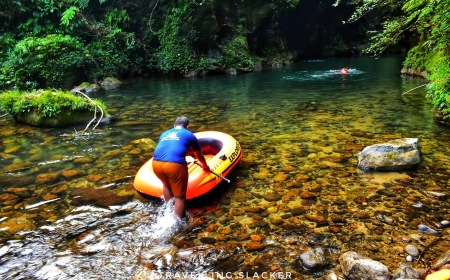How to Hike Knowland Park Oakland Zoo Trails
How to Hike Knowland Park Oakland Zoo Trails Knowland Park in Oakland, California, is more than just a green space—it’s a hidden gem for hikers, nature lovers, and urban explorers seeking a peaceful escape without leaving the city. Nestled between the bustling streets of East Oakland and the iconic Oakland Zoo, the park’s trail network offers a unique blend of natural beauty, wildlife observation,
How to Hike Knowland Park Oakland Zoo Trails
Knowland Park in Oakland, California, is more than just a green space—it’s a hidden gem for hikers, nature lovers, and urban explorers seeking a peaceful escape without leaving the city. Nestled between the bustling streets of East Oakland and the iconic Oakland Zoo, the park’s trail network offers a unique blend of natural beauty, wildlife observation, and historical context. While many visitors come to the zoo, far fewer explore the interconnected trails that wind through the park’s rolling hills, oak woodlands, and seasonal wildflower meadows. This guide provides a comprehensive, step-by-step resource for safely and enjoyably hiking the Knowland Park Oakland Zoo trails, whether you’re a first-time visitor or a seasoned local. Understanding these trails isn’t just about navigation—it’s about connecting with the ecosystem, respecting park regulations, and experiencing Oakland’s natural heritage firsthand.
The importance of knowing how to hike these trails extends beyond personal recreation. Knowland Park serves as a critical urban wildlife corridor, linking habitats from the hills to the bay. Responsible trail use helps preserve native flora and fauna, minimizes erosion, and ensures continued public access. Moreover, the trails offer an accessible outdoor experience for families, students, and seniors—making them a vital community asset. By learning how to navigate, prepare for, and appreciate these paths, you contribute to their sustainability and enrich your own connection to the natural world.
Step-by-Step Guide
1. Research and Plan Your Route
Before setting foot on any trail, take time to understand the layout of Knowland Park and its connections to the Oakland Zoo. The park spans approximately 180 acres and features multiple interconnected trails, some of which are unpaved and vary in difficulty. The most popular entry point is the main parking area near the zoo’s eastern boundary, off 98th Avenue. From there, trails branch toward the park’s interior, the ridge line, and the historic Knowland Family Cemetery.
Use digital tools like AllTrails, Google Maps, or the City of Oakland Parks and Recreation website to review trail maps. Look for trails labeled “Zoo Loop,” “Ridge Trail,” and “Oakland Zoo Connector.” These are well-maintained and clearly marked. For beginners, start with the 1.2-mile Zoo Loop, which circles the perimeter of the zoo grounds and offers gentle elevation changes. More experienced hikers may opt for the 2.8-mile Ridge Trail, which ascends to panoramic views of the East Bay.
Plan your route based on your fitness level, time availability, and interests. If you want to see wildlife, choose trails near the zoo’s animal enclosures during morning hours. If you prefer solitude and wildflowers, aim for late spring or early summer on the less-traveled paths toward the park’s western edge.
2. Check Weather and Trail Conditions
Weather in Knowland Park can shift rapidly due to its microclimate. Morning fog is common in spring and fall, while summer afternoons can become hot and dry. Always check the forecast before heading out. Avoid hiking during heavy rain—mudslides and slippery trails are common on the steeper sections. The park’s official website and social media pages often post real-time trail alerts for closures due to maintenance, wildlife activity, or fire risk.
In late spring, poison oak is abundant along trail edges. Familiarize yourself with its three-leaf pattern and avoid brushing against it. Trails may also be temporarily closed during nesting season for native birds like the red-tailed hawk or the California quail. Respecting these closures protects both wildlife and hikers.
3. Gather Essential Gear
Proper gear transforms a casual walk into a safe, enjoyable hike. At a minimum, bring:
- Sturdy hiking shoes or trail runners with good grip—many paths are rocky or root-covered.
- At least 1 liter of water per person, even for short hikes. Dehydration occurs faster than you think on sunny days.
- A small backpack to carry essentials: sunscreen, hat, snacks, phone, and a lightweight rain jacket.
- Trail map or offline GPS app (like Gaia GPS or Maps.me) since cell service can be spotty in wooded areas.
- Hand sanitizer or wipes—restrooms are limited.
- Whistle or personal alarm for safety in case of separation from your group.
Do not rely on the zoo’s facilities for trail access. The zoo’s restrooms and water fountains are for zoo patrons only. Plan accordingly.
4. Enter the Park and Locate Trailheads
There are three primary access points to the Knowland Park trails:
- Main Entrance (Zoo Side): Park in the lot adjacent to the Oakland Zoo’s eastern fence (off 98th Ave). Look for a wooden sign that reads “Knowland Park Trails” near the bike rack. This is the most popular entry and connects directly to the Zoo Loop.
- 98th Avenue Trailhead: A smaller, less crowded entrance near the corner of 98th and Foothill Blvd. This leads to the Ridge Trail and is ideal for those seeking solitude.
- East Ridge Park Connector: Accessible via a paved path from East Ridge Park (off 88th Ave). This is a longer approach but offers a gradual climb and fewer crowds.
Once inside, follow the blue trail markers (the official color used by Oakland Parks) to stay on designated paths. Avoid creating new trails—trampling vegetation accelerates erosion and disrupts wildlife.
5. Navigate the Main Trails
Each trail has distinct characteristics. Here’s how to navigate them:
Zoo Loop (1.2 miles, Easy)
This loop hugs the zoo’s perimeter and is ideal for families. It’s mostly flat, with wide, packed dirt paths. Watch for interpretive signs detailing local fauna—like the bobcat, coyote, and gray fox—that inhabit the park. The trail passes behind the lion and tiger enclosures, offering quiet viewing opportunities. Stay on the path; animals may be resting or feeding nearby.
Ridge Trail (2.8 miles, Moderate)
Starting from the 98th Avenue entrance, this trail climbs steadily through coastal scrub and live oak groves. It’s shaded in the morning but exposed in the afternoon. The trail ends at a viewpoint overlooking Lake Merritt and downtown Oakland. Look for native plants like manzanita, ceanothus, and California poppy. Be prepared for loose gravel on the steeper sections. Descend via the same route or connect to the East Ridge Connector for a loop.
Historic Cemetery Path (0.5 miles, Easy)
Located near the park’s western edge, this short, flat trail leads to the Knowland Family Cemetery, established in the 1850s. It’s a quiet, reflective spot with interpretive plaques about the park’s early settlers. Stay on the marked path—this area is protected as a historical site.
6. Interact Responsibly with Wildlife
Knowland Park is home to over 200 species of birds, mammals, reptiles, and insects. You may encounter raccoons, opossums, deer, and even the occasional mountain lion (rare but documented). Never feed wildlife. Store food securely. If you see a coyote or bobcat, do not approach. Back away slowly and make noise to discourage it from coming closer.
Watch for signs of animal activity: tracks in soft soil, scat near trails, or claw marks on trees. These are natural indicators of healthy ecosystems. Use binoculars to observe from a distance. The Oakland Zoo’s wildlife education team often places signage along trails to help identify species—take time to read them.
7. Exit Safely and Leave No Trace
When finishing your hike, return to your starting point. Do not cut through private property or use unauthorized exits. Before leaving, conduct a “Leave No Trace” checklist:
- Collect all trash, including food wrappers and biodegradable items like apple cores.
- Do not pick flowers, move rocks, or take souvenirs.
- Stay on designated paths to prevent soil compaction.
- Ensure your dog is leashed (if allowed) and clean up after them.
Report any trail damage, graffiti, or hazardous conditions to the Oakland Parks and Recreation department via their online form. Your input helps maintain the trails for future visitors.
Best Practices
Timing and Seasonality
The best times to hike Knowland Park are early morning (6–9 a.m.) or late afternoon (4–7 p.m.). These hours offer cooler temperatures, better lighting for photography, and increased wildlife activity. Spring (March–May) is ideal for wildflower blooms and bird migrations. Summer can be dry and dusty, but the trails are less crowded. Fall brings golden oak leaves and crisp air—perfect for longer hikes. Winter is the wettest season; trails may be muddy, but the park is lush and green.
Avoid hiking during peak zoo hours (10 a.m.–4 p.m.) if you seek quiet. The zoo’s busiest days are weekends and holidays, when parking fills quickly and noise levels rise. Weekday mornings are your best bet for solitude.
Group Hiking and Safety
If hiking with children, elderly companions, or pets, choose the Zoo Loop or Cemetery Path. Keep children close—some trail edges drop sharply. Use a stroller only on paved access paths; the main trails are not stroller-friendly.
Always hike with a buddy. Inform someone not on the hike of your planned route and estimated return time. Carry a fully charged phone, but don’t rely on signal. Download offline maps and save emergency numbers for Oakland Parks and the Alameda County Sheriff’s Office.
Respect Cultural and Historical Sites
Knowland Park is not just a natural space—it’s a place of cultural significance. The Knowland family, prominent Oakland landowners in the 19th century, once owned the land. The cemetery and a few original stone walls remain as reminders of this history. Do not sit on or climb historic structures. Avoid loud music or disruptive behavior near these sites.
Environmental Stewardship
Every hiker has a role in preserving the park. Avoid single-use plastics. Bring a reusable water bottle and refill at home before arriving. Pick up litter—even if it’s not yours. Participate in volunteer trail cleanups hosted by the Oakland Parks Foundation. These events occur monthly and are open to all.
Also, be mindful of invasive species. Plants like French broom and Himalayan blackberry can outcompete native vegetation. If you spot them, report them to park staff. Do not transport plant material between parks.
Trail Etiquette
Follow the universal trail rules:
- Yield to uphill hikers—they’re working harder.
- Step aside to let faster hikers pass on the right.
- Keep dogs on leash unless in a designated off-leash zone (none exist in Knowland Park).
- Keep voices low to preserve the natural soundscape.
- Do not play music from portable speakers.
These practices ensure everyone—hikers, birds, and butterflies—can enjoy the space peacefully.
Tools and Resources
Digital Mapping and Apps
Modern technology enhances trail safety and enjoyment. Here are the most reliable tools:
- AllTrails: Offers user reviews, photos, elevation profiles, and real-time trail conditions for Knowland Park. Filter by “dog-friendly,” “family-friendly,” or “easy.”
- Gaia GPS: Download offline maps for Knowland Park and the Oakland Zoo trails. Use the “Topo” layer to see contour lines and elevation changes.
- Google Earth: Use the historical imagery feature to see how the park has changed over decades.
- iNaturalist: A citizen science app to identify plants and animals you encounter. Your observations contribute to scientific databases.
Official Resources
Always refer to trusted sources for updates:
- Oakland Parks and Recreation Website: www.oaklandca.gov/topics/parks-and-recreation – Official trail maps, closures, and permit information.
- Oakland Zoo Website: www.oaklandzoo.org – Information on zoo hours and how trails connect to zoo grounds.
- Oakland Parks Foundation: www.oaklandparksfoundation.org – Volunteer opportunities, educational programs, and trail advocacy.
- California Native Plant Society – East Bay Chapter: Offers guided wildflower walks and plant identification resources.
Books and Guides
For deeper knowledge, consider these publications:
- “Hiking the East Bay” by Richard A. Lertzman – Includes a dedicated chapter on Knowland Park with historical context.
- “Native Plants of the San Francisco Bay Region” by Mark A. Moran – Essential for identifying flora along the trails.
- “The Urban Wild: Finding Nature in the City” by Karen L. K. Winters – Explores the ecological importance of parks like Knowland.
Equipment Recommendations
For optimal comfort and safety:
- Footwear: Merrell Moab 3 or Salomon X Ultra 4 GTX for grip and ankle support.
- Backpack: Deuter Speed Lite 20 or Osprey Talon 22 for lightweight carrying.
- Hydration: Platypus 2L hydration bladder or Nalgene bottle with carabiner clip.
- Navigation: Garmin inReach Mini 2 for satellite messaging in areas without cell service.
- First Aid: Compact kit with tweezers (for ticks), antiseptic wipes, blister pads, and epinephrine if allergic.
Real Examples
Example 1: Family Hike – The Zoo Loop with Kids
Sarah, a mother of two from San Leandro, brought her 5-year-old and 8-year-old to Knowland Park on a Saturday morning. She planned a 90-minute outing using the Zoo Loop trail. She packed snacks, water, and a small field guide to birds. They spotted a red-tailed hawk perched on a fence, a family of deer grazing near the trees, and a painted turtle near a puddle. Her kids loved the zoo’s interpretive signs and took photos of each animal they saw. Sarah used the AllTrails app to track their distance and time. They finished with a picnic at the shaded benches near the 98th Avenue entrance. No one got lost, no one got tired, and everyone left feeling connected to nature.
Example 2: Solo Hiker – The Ridge Trail for Photography
Diego, a freelance photographer from Berkeley, hikes Knowland Park every other Sunday. He targets sunrise on the Ridge Trail to capture mist rolling over the Oakland hills. He uses a tripod and wide-angle lens to frame the contrast between the zoo’s enclosures and the wild landscape beyond. He avoids weekends to prevent crowds. He carries a portable battery pack for his camera and a journal to record weather conditions and wildlife sightings. One morning, he photographed a bobcat crossing the trail—rare and fleeting. He uploaded the image to iNaturalist, where it was verified by a wildlife biologist. His photos were later featured in a local nature exhibit.
Example 3: Community Volunteer – Trail Restoration Day
A group of 15 high school students from Oakland Technical High School participated in a monthly trail cleanup hosted by the Oakland Parks Foundation. They removed invasive blackberry vines, planted native sagebrush and buckwheat, and installed new trail signage. They learned about erosion control and the importance of native plants in supporting pollinators. Afterward, they hiked the same trail they’d restored, observing butterflies feeding on the new flowers. One student wrote in her reflection: “I thought parks just happened. Now I know people have to work to keep them alive.”
Example 4: Senior Hiker – Gentle Walks for Wellness
Ellen, 72, walks the Cemetery Path three times a week. She uses a walking stick and takes breaks on the wooden benches. She says the quiet, shaded trail helps her manage arthritis and depression. She brings her grandchild every other visit, teaching them about the history of the Knowland family. “It’s not exercise,” she says. “It’s peace.” Her routine has become a model for the city’s “Healthy Aging in the Parks” initiative, which now offers guided senior walks on Tuesdays.
FAQs
Can I bring my dog on the Knowland Park trails?
Dogs are allowed on the trails but must be kept on a leash at all times. Leashes must be six feet or shorter. Owners are responsible for cleaning up after their pets. Dogs are not permitted inside the Oakland Zoo, even on a leash. Do not leave dogs unattended in vehicles.
Are the trails wheelchair accessible?
The paved access paths from parking lots and the Cemetery Path are wheelchair-friendly. However, the main hiking trails (Zoo Loop, Ridge Trail) have uneven surfaces, roots, and steep sections that are not suitable for wheelchairs or mobility scooters. The Oakland Zoo offers a separate accessible trail for zoo patrons only.
Is there a fee to hike Knowland Park?
No. Knowland Park is publicly owned and free to access. The Oakland Zoo charges admission, but the park trails are separate and do not require a zoo ticket. You can hike the trails without entering the zoo.
Are there restrooms on the trails?
There are no public restrooms along the hiking trails. The nearest facilities are inside the Oakland Zoo, which require a zoo admission ticket. Plan accordingly. Portable restrooms are sometimes available during special events.
What should I do if I see an injured animal?
Do not attempt to handle or move the animal. Note the location and call the Oakland Zoo’s Wildlife Rescue Line at (510) 632-3770 or the East Bay SPCA at (510) 569-0250. They have trained responders who can assist safely.
Are there guided hikes available?
Yes. The Oakland Parks Foundation and the California Native Plant Society offer monthly guided hikes. Check their websites for schedules. These are free and open to the public. They often focus on botany, birding, or history.
Can I camp or have a bonfire in Knowland Park?
No. Camping, open fires, and alcohol are prohibited in Knowland Park. The park is open from sunrise to sunset. Overnight stays are not permitted.
Is the trail network connected to other regional trails?
Yes. The Ridge Trail connects to the East Ridge Park trail system, which links to the larger East Bay Regional Park District network. With proper planning, you can extend your hike to the Oakland Hills or even to Lake Chabot via multi-day routes.
What’s the best time of year to see wildflowers?
Mid-March through May is peak wildflower season. Look for California poppies, goldfields, lupines, and desert sunflowers in open, sunny areas. The best spots are near the zoo’s eastern fence and along the lower Ridge Trail.
Is it safe to hike alone?
Yes, but with precautions. Stick to well-traveled trails during daylight hours. Let someone know your plans. Carry a phone and a whistle. Avoid hiking alone in the early morning or late evening if you’re unfamiliar with the terrain.
Conclusion
Hiking the Knowland Park Oakland Zoo trails is more than a physical activity—it’s an act of reconnection. In a world increasingly dominated by screens and schedules, these trails offer a rare opportunity to walk among oaks, hear the wind through grasses, and witness the quiet resilience of urban wildlife. Whether you’re a parent seeking a safe outdoor experience for your children, a photographer chasing golden light, or a retiree finding peace in nature’s rhythm, Knowland Park welcomes you.
By following the steps outlined in this guide, you not only ensure your own safety and enjoyment but also become a steward of this vital green space. Every footstep on the trail, every piece of trash picked up, every invasive plant removed, contributes to the park’s future. The trails are not just paths—they are lifelines connecting people to place, history to habitat, and city to wild.
So lace up your shoes, pack your water, and step onto the trail. The hills are waiting. And so is the quiet, enduring magic of Knowland Park.





























